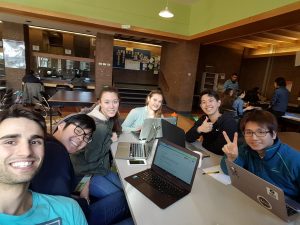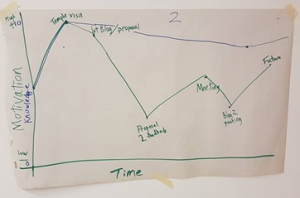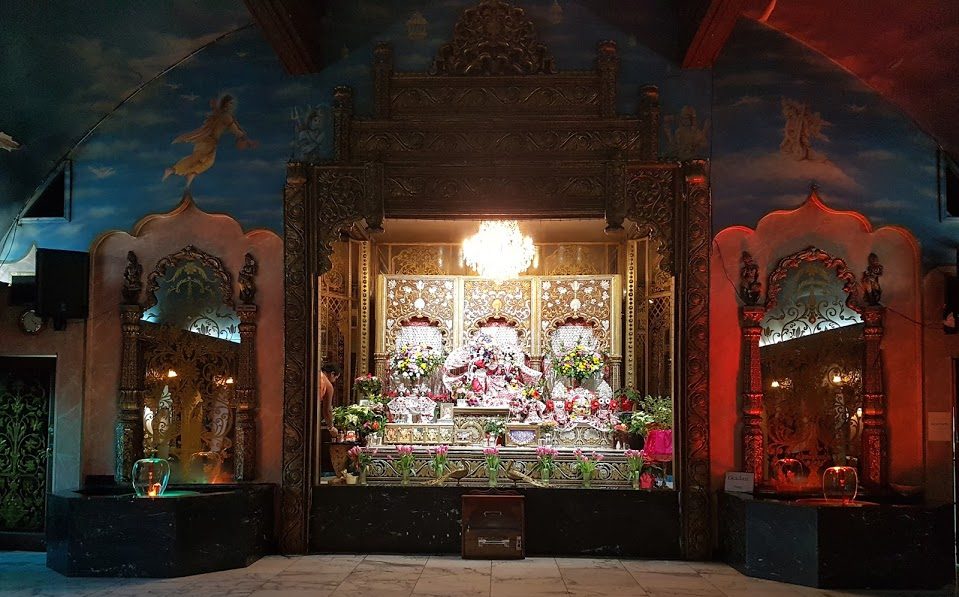Blog #3 – Strategies for a Graceful Dismount
Did you know: A university student’s mental wellbeing can be determined by the grades received on assignments and projects?
Weekly Objective
This week we have set up multiple goals in order to set our group up for future success. In the short-term, we will be editing the second draft of our blog post 2 to enhance its fluidity, reader engagement (through the use of a hook) and visuals aesthetics. As well, we have created a schedule for blog 3’s completion and intend on delegating roles for its optimization. For the long-term, we have begun to look into the criteria for the infographic and final report as it will help us identify the current major gaps within our project. We’re planning on using these identified gaps to work backwards from the final report in order to identify ways to fill these gaps. For example, perhaps we need to consider additional site visits with our community partner to be prepared to address these gaps or look towards academic literature for insight.
Weekly Achievements
It has been a week full of activities and progress for our LFS 350 project. We completed our class assignments consisting of our 2 blog submission as well as the academic and experiential review paper thesis statement. In addition, the majority of our group was able to visit the Temple to conduct an interview with Jaya Govinda, a member of the Hare Krishna Temple, and another devotee. This was extremely helpful as it increased our understanding of the Temple by solidifying information that we can incorporate into our final report and infographic. It was at this meeting that we were able to help clarify with Jaya Govinda the intent of our group project as it has changed over the past few weeks with the revision of our proposal. Lastly, we were able to meet as a whole team to debrief the second visit to the Hare Krishna Temple as well as appropriate steps in moving forward. This is an important achievement for our group as one of the objective that we had set in the previous week was to meet as a team to help with the team communication, and we have done so!

Moments of Significant Change workshop
An investigation of our motivation and knowledge throughout the semester was conducted through a reflective activity within our tutorial session. This activity allowed us to reflect on our individual understanding of our own feelings as well as those as an entire group.
What – In terms of our group knowledge, we feel that there has been a slow decline as the project went on. This mainly stems from the fact that as we learned more about the project, the larger its scope became resulting in many more questions and uncertainty. These feelings of uncertainty began to snowball, leading to an ever growing number of questions. However, we are optimistic about this in that we are beginning to see a slowly increase in our ability to to see interconnections between Hari Krishna faith, food and provision of community meals as we continue to do our research on the Temple. After all, “in the presence of uncertainty, one is obligated to learn from experience” (Shulman, 2005) and find ways to fill in these knowledge gaps.

Figure 1: Graph of motivation (green) and knowledge (blue).
In terms of our motivation, we noticed that it peaked with our first visit to the Temple. This is because we had learned a lot, began to form a relationship with the members of the community, and had an idea of the direction our project could take in regards to the onsite gardens they posses. It is important to us to keep the motivation of our group on the positive side, however our motivation then fell slightly after submitting our first blog post due to the feedback we received in combination with the difficulties we experienced in coordinating a blog post with so many diverse voices. Our motivation then further declined after submitting and receiving feedback on our project proposal. We had thought that we had produced a high degree of quality in our proposal and were initially confused as to why that was not being reflected in the feedback we received. We decided to seek help by talking with our TA Colin and he provided much more clarity as where the score of our project should be focused reigniting our motivation. Although our understanding of the project motivated us, the challenges associated with any group collaboration regarding communication made the second blog difficult to complete and dropped our motivation slightly again. But now after going to our 2nd visit to the Temple and discussing as a whole group, we feel as though our motivation is increasing and hopefully will continue to do so through to the end of the term.
So What – Every time our motivation drops, or our perceived amount of knowledge we have on that subject drops, we gain various skills such as teamwork, communication, time management and an overall professionalism that will be needed when we enter the workforce. Facing these disenchanting moments may cause anxiety and stress, but as Shulman (2005) emphasizes “ without a certain amount of anxiety and risk, there’s a limit to how much learning occurs.” Full certainty can be pursued in classes such as mathematics, where there is one correct answer, but as professionals we will need to be able to make decisions under circumstances when they are various answers causing lots of uncertainty. Being able to make good responsible decisions under these conditions is perhaps the most valuable skill that this course is teaching us (Shulman, 2005).
Group Strategies for Successful Project Completion
Now What – There are three main strategies that our group has agreed to implement for the successful completion of our project. Taking the steps to complete the project will hopefully lead us to a successful end product.
- Understanding and integrating our objectives. Much has changed through this course on the direction of our project and it is key for our success that we have a clear understanding of our objectives. These objectives will come into play when we are composing our final report and infographic. We need to truly understand the objectives that we have come up with in the beginning and how we have to alter them going forward.
- Integration of academic sources. We have obtained much information regarding the Temple through interviews and site observations. We are now looking towards integrating this information with academic sources to understand the underlying theories behind what we have seen. As a group, we will be looking at the literature through our own research as well as using the literature that was presented in our LFS 350 classes. We are going to comprehend what is being said in our research and linking it to our experiences in the temple and throughout our project.
- Continuing to use an asset based community development/engagement approach to complete our project. It can be very easy to think in terms of ‘deficits’ within our given project, how we can help the Temple fill a niche role that they may be currently struggling with. However, this is not the goal of our project. In order to foster an understanding and more importantly an appreciation for the Hari Krishna Temple, we need to keep our focus on what the Temple is currently contributing to it’s members and the surrounding community. For example, the provision of karma free food enables members to come together and engage with one another over a culturally appropriate meal that can act as a means to provide food security without racial judgement. By using this assets framework, we will continue to recognize that our community partner has a unique set of talents to contribute to any future project; we as outside academics are not the only people who can apply program implementations in a given community as a means to address large scale food system issues such as food security or food justice (The University of Memphis, 2017).
References:
Shulman, L. S. (2005). Pedagogies of uncertainty. Liberal Education, 91(2), 18.
University of Memphis. (2017). Differences in framing community work. Module 4- Asset Based Community Engagement. Retrieved from http://www.memphis.edu/ess/module4/page2.php.
